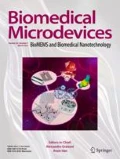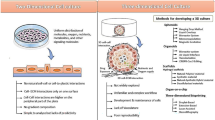Abstract
Usually cell-based assay is performed using titer plates. Because of the large library of chemical compounds, robust and rapid methods are required to find, refine and test a potential drug candidate in an efficient manner. In this article, the drug effects analysis on human breast cancer cells with a droplet microfluidic chip is reported. Each droplet serves as a nanoliter-volume titer plate and contains a human breast cancer cell MDA-MB-231, Cytochalasin D drug solution and cell viability indicator such as Calcein AM, which emits cytoplasmic green fluorescence. The drug effects on each cell are monitored in real time using a fluorescence microscope and by analyzing the fluorescence image of each cell. Clear change of the cell shape and size has been observed after the drug treatment, which is similar to that of conventional petri dish technique, suggesting this approach is a potential viable technical platform for drug effect analysis and for high throughput drug screen and discovery.








Similar content being viewed by others
References
J. Atencia, D. Beebe, Nature 437, 648–655 (2005)
P. Dittrich, A. Manz, Nat. Rev. Drug Discov. 5, 210–218 (2006)
Z. Gong, S. Penmesta, Z. Zheng, Y. Lvov, L. Que, Tech. Digest Transducers’ 09, 1043–1046 (2009)
Z. Gong, F. Nie, T. Zhang, H. Zhao, S. Wong, L. Que, Proc. IEEE MEMS, 1015–1018 (2010)
D. Haussinger, J. Biochem. 313, 697 (1996)
S.Z. Hua, T. Pennell, Lab Chip 9, 251–256 (2009)
L. Kang, B. Chung, R. Langer, A. Khademhosseini, Drug Discov. Today 13, 1–13 (2008)
S. Madisetti, Z. Zheng, Z. Gong, S. Penmetsa, Y. Lvov, L. Que, Proc. IEEE NEMS, 440–443 (2009)
F. Sachs, Nat. Struct. Biol. 9, 636–637 (2002)
H. Song, D.L. Chen, R.F. Ismagilov, Angew. Chem. Int. Ed. 45, 7336–7356 (2006)
R.K. Shah, H.C. Shum, A.C. Rowat, D. Lee, J.J. Agresti, A.S. Utada, L. Chu, J. Kim, A. Fernandez-Nieves, C.J. Martinez, D.A. Weitz, Materials Today, 11, 18–27 (2008)
Y. Tan, K. Hettiarachchi, M. Siu, Y. Pan, A. Lee, J. Am. Chem. Soc. 128, 5656–5658 (2006)
B. Zheng, J. Tice, R. Ismagilov, Adv. Mater. 16, 1365–1368 (2004a)
W. Zheng, R.H. Spencer, L. Kiss, Assay and Drug Development Technologies 2(5), 543–552 (2004b)
Acknowledgements
This work is partly supported by the NSF grant EECS0845370and NSF-Pfund-2008 to LQ and by NIH R01 CA121225 to SW.
Author information
Authors and Affiliations
Corresponding author
Rights and permissions
About this article
Cite this article
Gong, Z., Zhao, H., Zhang, T. et al. Drug effects analysis on cells using a high throughput microfluidic chip. Biomed Microdevices 13, 215–219 (2011). https://doi.org/10.1007/s10544-010-9486-2
Published:
Issue Date:
DOI: https://doi.org/10.1007/s10544-010-9486-2




